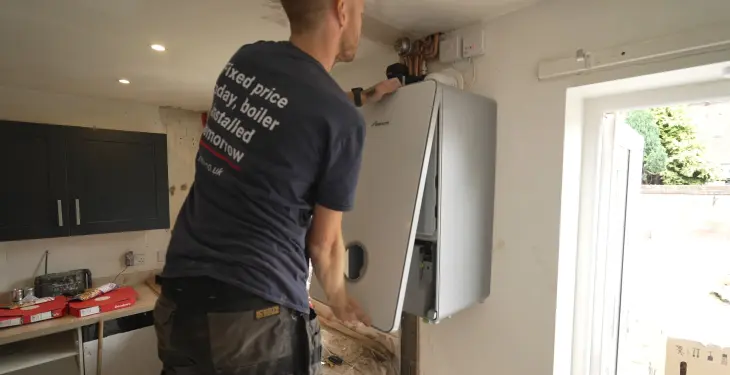

Written by Stephen Day
Gas Safe Engineer
Updated: 27th October, 2025
Everything UK homeowners need to know about immersion heaters and running costs.
Get a new boiler quote, save up to £550 per year (0% APR available).
Immersion heaters are still quite popular with certain properties, and you may be considering having one installed in your home to provide hot water for your family.
We have created this definitive guide to immersion heaters, letting you know what they are, how they work and (most importantly) how much they will cost so you can decide whether they are a good option for your home.
First, we need to address the heater in the room. You will not be able to consider getting an immersion heater installed in your home without understanding what one is in the first place.
Immersion heaters use electricity to heat water so you can use it. They can also be connected to solar panels, making them highly efficient for these eco-conscious times.
These kinds of heaters can also be called megaflow boilers or invented hot water systems, so keep your eyes out for these names when looking into different brands or companies.
These heaters are electric water heaters inside a hot-water cylinder. They rely on an electric-resistant heater, which looks like a metal hoop or coil, to heat the surrounding water.
They are connected to their power source through a cable, like an electric kettle. This makes it easy to switch on or off your immersion heater, so you do not have to use it all the time and waste energy.
Immersion heaters can be used as a primary heater for your property or a backup water heater for properties that already use a combi boiler.
This means they are versatile and could be ideal for your home or business.
Think of an immersion heater like an electric kettle, as they operate similarly.
Both devices use a metal element, like a coil or hoop, that is immersed in the water and will heat it once it has been turned on.
Immersion heaters are connected to the mains electricity using a cable and come with their own on/off switch. This allows you to control the heating of water in your home and decide when it is needed most.
Once the immersion heater has been switched on, the metal element in the water will start to heat up, which in turn will increase the temperature of the water it is in.
Depending on the immersion heater you use, it could take one to two hours for the water to heat up. Insulating layers can be very beneficial, maintaining a warm temperature and decreasing heating-up time.
If you are considering installing a new heater or boiler system in your home, this is perhaps the most important question.
It has been said that they are not the most affordable options, especially for family homes, where you need access to a lot of hot water at all hours of the day.
This is because when you use an immersion heater, you will be heating a large amount of water when you may only need a small amount. For example, when you turn the hot tap on in your kitchen sink to wash your hands after cooking, you will be heating the whole tank of water surrounding your immersion heater even though you only need a small amount.
Using an immersion heater at home can also mean waiting a long time for your water to heat up. This will mean planning for your evening bath, so you have given the heater enough time to get to work.
It is recommended that you to insulate the hot water tank when using an immersion heater, as this will speed up the time it takes for the water to get to the right temperature.
This will save you money as you will not have to keep your heater on for as long.
As we have mentioned, using an immersion heater can take a long time for water to heat up. This means you must either plan for every use of hot water or leave it running all the time.
Some people will argue that it is always better to leave your immersion heater on. They will claim that not only does this give you constant access to hot water, which is ideal for most family homes, but that it can be more energy efficient when compared to constantly turning it off and on.
Well, it may be easier for you to always leave your immersion heater on if you constantly need hot water, but who needs hot water all the time?
As long as you use an immersion heater with a good insulating layer or jacket, it should keep water at a warm temperature all day, even once it has been turned off. If you need hot water, it shouldn’t take too long to reach the desired temperature once it has been turned back on.
It is a good idea to install a timer and temperature control into your immersion heater to give you greater control over it.
With a timer, you can decide when you want it to turn on and heat water. For example, if you have the same bath time every night for your kids, set the immersion heater to automatically turn on a couple of hours before so you will be prepared.
Most household appliances, like washing machines, dishwashers, and even electric showers, have their supply of cold water that they will heat themselves, so you do not need to worry about having the immersion heater on when using these.
Immersion heaters will only provide warm water to your home or property. This is why many properties will use immersion heaters alongside another type of boiler, like a combi, to provide them with a backup source of hot water.
If you are interested in a combi boiler, then read our article on our best combi boilers.
One of the biggest advantages of immersion heaters is that they are separate from your boiler. This is why they cannot heat radiators on their own, but they do give you some backup power should your boiler stop working.
When using an immersion heater as a backup alongside another type of boiler, you will still have access to hot water even if your boiler breaks down.
Using one with a thermostat will save you money, as you can control the desired temperature and shut the heater off once it reaches this.
It is possible to purchase an immersion heater with thermostats. This is recommended for most properties as it can help you save money and will give you more control over the hot water in your home.
Thermostats and timers can be controlled to fit your routine and needs.
Those with a thermostat can be programmed to turn off once they reach a certain temperature. If you have an immersion heater that is well insulated, then it can remain at this temperature for several hours, saving you money on your energy bills.
Immersion heaters with a thermostat can be controlled to suit your needs and are much easier to manage.
There are a lot of options when it comes to heating and boiler systems, so, likely, the first one you look at won't be the right fit.
But they can be quite beneficial in some circumstances.
Households that do not have a gas supply, like flats, will need to use immersion heaters as this will be their only source of hot water.
However, this does not apply to everyone. Most homes will have access to some other heater or boiler, but could still benefit from using an immersion heater as a backup.
Most homes will use a combined central heating and hot water system as this is most reliable and suitable for our modern needs as they can be easily controlled. In this case, an immersion heater can be installed as a backup should your boiler break down.
This will allow you access to hot water while you wait for your main system to be restored.
Immersion heaters aren’t suitable for everyone, but there are some significant benefits to having this system on your property.
Immersion heaters with a thermostat can be very energy-efficient as they will automatically shut off once they have reached the desired temperature
Well-insulated heaters can keep water warm for several hours so they will not need to be switched on again
Timers can be installed so you can program your immersion heater to fit with your routine or off-peak hours for a cheaper energy bill
Immersion heaters are very easy to use as they have a simple on/off switch
They can be used as a backup system should your main boiler break
When installing an immersion heater into your property, there are some things you will want to consider – especially if you are using it as your main hot water source.
These heaters rely on electricity, making them more expensive than traditional boilers or combined systems.
This is made more expensive because the will typically need to be switched on for around two hours to provide hot water. This can add up to quite the bill at the end of the month.
The cost of running an immersion heater may put a lot of households off, but there is no denying that there is still a place for these devices, even with our modern needs.
In the heating systems debate, modern gas boilers and immersion heaters each have their unique merits.
However, for many homeowners, modern gas boilers often emerge as the more efficient, cost-effective, and adaptable choice.
This in-depth analysis will delve into the reasons behind this preference, clarifying technical terms and providing practical insights.
Modern gas boilers from brands like Vaillant, Viessmann, and Worcester Bosch embody efficiency.
For example, the Vaillant ecoTEC and Viessmann Vitodens series, with their high-efficiency ratings, significantly reduce energy consumption compared to traditional immersion heaters.
These boilers employ 'condensing technology,' a method where water vapour in exhaust gases is condensed to recover latent heat, which is then reused.
This technology ensures that nearly all the energy is utilised effectively, contrasting with older immersion heaters' lower efficiency levels.
While modern gas boilers may initially cost more than immersion heaters, their long-term financial benefits are significant.
These boilers, due to their higher efficiency (often exceeding 90%), result in lower energy bills. Over time, the savings gained from reduced energy consumption can offset the initial investment.
Additionally, with the volatile energy market and rising electricity costs, gas heating remains a more economically viable option in the UK.
Modern gas boilers offer a dual function: they efficiently heat homes and provide hot water. This adaptability makes them ideal for various home sizes and climates, especially in larger homes where consistent heating is vital.
Models like the Worcester Bosch Greenstar and Ideal Logic Plus adapt to diverse heating requirements, offering a more comprehensive solution than immersion heaters, which are primarily designed for water heating.
A key advantage of modern gas boilers is their ability to heat water more rapidly than immersion heaters.
This feature is crucial in households with high hot water demands. The Alpha E-Tec range, for example, provides quick water heating and meets high usage needs efficiently.
These boilers are also more effective in central heating systems, ensuring an evenly heated environment.
Modern gas boilers have evolved to meet stricter environmental standards, with manufacturers focusing on reducing emissions and enhancing efficiency.
The latest models from Vaillant and Viessmann, for instance, are designed to have a lower carbon footprint compared to traditional heating methods, making them a greener choice.
Modern gas boilers are known for their durability and reliability. With proper upkeep, these boilers can last over a decade, ensuring consistent heating and hot water.
Regular maintenance, like annual servicing and routine checks, extends their lifespan and maintains efficiency, offering better long-term value compared to immersion heaters.
'Condensing Technology': This refers to a boiler’s ability to condense water vapour in exhaust gases to reclaim heat, enhancing efficiency.
'Latent Heat': This is the heat released or absorbed during a phase change, like water vapour condensing back into water.
'Efficiency Rating': This metric indicates how effectively a boiler converts energy into heat. Higher ratings mean better energy utilisation.
Maintaining a gas boiler involves regular professional servicing and simple homeowner checks.
Ensure the pressure gauge reads correctly, listen for unusual sounds, and keep the boiler area clear. Simple, proactive maintenance can significantly boost a boiler's performance and longevity.
While immersion heaters have specific applications, modern gas boilers stand out for their overall efficiency, cost-effectiveness, adaptability, and environmental friendliness.
They represent a more comprehensive and efficient solution for home heating, making them a preferred choice for many households.
Last updated: 27th October, 2025

Written by Stephen Day
Gas Safe Engineer at iHeat
Stephen Day is a Gas Safe registered and FGAS certified engineer with over 20 years of hands-on experience in the heating, cooling, and renewable energy industry, specialising in boiler installations, air conditioning, and heat pump systems.
LinkedInArticles by Stephen Day are reviewed by iHeat’s technical team to ensure accuracy and reliability.

22nd December, 2025
Based on data from over 7000 boiler installations completed by iHeat in the past 12 months...
 Read Article
Read Article

22nd December, 2025
Here’s a quick roundup of the best combi boilers for 2026.
 Read Article
Read Article

22nd December, 2025
When your old boiler breaks down and it comes time to replace it with a new one, it might...
 Read Article
Read Article
No obligation. Takes less than 60 seconds.